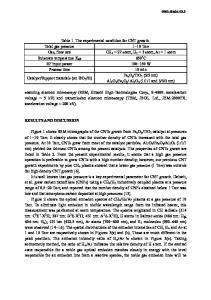Diamond growth by hollow cathode arc plasma chemical vapor deposition
- PDF / 438,845 Bytes
- 8 Pages / 612 x 792 pts (letter) Page_size
- 47 Downloads / 419 Views
MATERIALS RESEARCH
Welcome
Comments
Help
Diamond growth by hollow cathode arc plasma chemical vapor deposition Gou-Tsau Liang and Franklin Chau-Nan Honga) Department of Chemical Engineering, National Cheng-Kung University, Tainan, Taiwan 701, Republic of China (Received 12 May 1997; accepted 23 January 1998)
Hollow cathode arc plasma chemical vapor deposition was employed to grow crystalline diamond films using 1.5% to 7% of methane in hydrogen. The growth rate was as high as 3.2 myh when using 5% CH4yH2 at a pressure of 15 Torr and a substrate temperature of 1083 K. However, an intermediate layer of several hundred nanometers was observed at the film-substrate interface by cross-section SEM. Raman and XPS characterizations showed that the interfacial layer consisted of sp 2 carbon and TaC with Ta vaporized from the hot cathode tube. XRD and XPS results further showed that the deposited diamond films also contained TaC. Ta composition in the film increased with the increase of growth pressure, the reduction of substrate temperature, and the increase of H2 flow in the Ta tube. The diamond films deposited by using CHCl3 as carbon source had Ta concentrations one order of magnitude higher than those using CH4 , as shown by XPS results, but the nucleation densities using CHCl3 were always higher than those using CH4 . I. INTRODUCTION
Diamond films have great potentials in many future advanced technologies owing to their combination of many excellent chemical and physical properties, e.g., the highest hardness and thermal conductivity at room temperature, very large band gap, transparency in a wide range of light spectrum, extremely low friction coefficients, resistance to strong acids and bases, etc. Diamond films can be deposited by many chemical vapor deposition (CVD) methods, including hot-filament CVD,1,2 microwave plasma CVD,3,4 dc plasma CVD,5,6 plasma jet CVD,7,8 combustion methods,9 etc. Hollow cathode arc plasma CVD is a modified version of dc plasma CVD. Under the influence of symmetric voltage drops near the cathode tube walls, electrons can oscillate inside the tube to produce a hollow cathode discharge, exhibiting a plasma density at least one order of magnitude higher than a dc diode discharge.10 By gradually raising the hollow cathode discharge current, a transition from the discharge into arc occurs abruptly as the current suddenly rises and the voltage drops rapidly turning the cathode tip into incandescence, generating an extremely high density of plasma. As a result, hollow cathode arc plasma CVD combines both the advantages of a high cathode temperature (.2273 K) and a high plasma density, dissociating H2 into a high concentration of H for fast diamond depositions. Hollow cathode arc also produces a high electron flux onto the substrate, likely facilitating the low temperature growth and ena)
Address all correspondence to this author. e-mail: [email protected]
3114
http://journals.cambridge.org
J. Mater. Res., Vol. 13, No. 11, Nov 1998
Downloaded: 14 Mar 2015
hancing the nucleation d
Data Loading...











